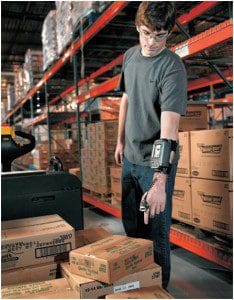
One of the first things people ask when investigating voice picking and other mobile applications for their DC is “how will the new applications work with my existing systems?” There are 3 common myths when it comes to adding new voice solutions to existing host or warehouse management systems (WMS):
- The Legacy Myth – You need a Tier 1 WMS to use voice-directed mobile applications so you should replace your custom-built systems or upgrade your legacy WMS package before looking at other solutions.
- The Integration Myth – Adding new mobile applications to a WMS requires complex custom integration work.
- The All-In-One WMS Myth – A WMS voice module provides all the benefits of a best-in-breed warehouse optimization solution at a lower cost.
The Legacy Myth
The myth here holds that voice-directed mobile applications can only be added to a Tier 1 WMS, and that if you have a home-grown inventory system or an older ERP or WMS package, you should install a new WMS before you think about new mobile apps.
The fact is that most DCs have installed voice-directed mobile applications with host or legacy packages and made the decision later whether to upgrade to a new WMS. The ‘mobile-first’ approach is actually more cost-effective and makes the WMS transition easier for users.
Warehouse management software packages are progressively growing a foothold in DCs of all sizes, but many DCs continue to use custom-developed, host-based inventory systems or older, legacy WMS or ERP packages. Contrary to what you may have heard from some in the industry, legacy systems are not an impediment to installing new mobile work applications.
The main driver for replacing paper or RF-based processes with voice-directed mobile applications is to improve the accuracy and efficiency of picking and other hands-on processes, but there are additional benefits available in mobile work solutions. These “orchestration” solutions provide highly configurable, flexible, and efficient workflows that combine voice, scanning and displays, in addition to real-time management tools such as workflow management, exception reporting, and productivity tracking. These management tools often fill gaps in existing systems, giving managers better insight and control of their operations.
By filling these gaps, a new mobile solution often prolongs the life and value of host or legacy systems. And the productivity and accuracy gains achieved with new applications deliver ongoing cost savings that help companies pay for their larger, longer-term WMS upgrades or replacements.
Additionally, with today’s challenges in hiring and retaining hourly workers, the voice-directed solution has been proven to reduce training time for new associates, making it easier for the new worker to learn the job, and more importantly, to meet or exceed the expectations of the position. By making the job “easier to learn and do”, the new associate can feel greater job satisfaction, and will be easier to retain.
Another overlooked advantage of adding mobile applications to a legacy system is that this approach can simplify the transition to a new WMS in the future. When the WMS is replaced, the voice-directed processes for workers can remain the same, minimizing training and ramp up time.
Given the short time it takes to install new mobile applications (3-4 months) and their rapid return on investment (often less than one year), most companies install voice-directed mobile applications ahead of purchasing a new WMS. If your current system meets your inventory management and planning needs, a robust warehouse optimization solution can immediately improve your hands-on processes, fill management and visibility gaps in existing systems, and even ease your transition to a new WMS in the future.
The Integration Myth
This myth proposes that integrating mobile applications with existing WMS or host systems requires custom programming that is difficult, costly, and risky. What’s true in this case is that standards-based integration technologies and mature WMS application interfaces minimize the complexity, cost and risks of adding voice and mobile applications to an existing WMS or host.
While this myth had some veracity in the early years of voice-directed applications, the software industry has adopted open, standards-based integration technologies that reduce the cost and risk of application integration. Most WMS packages delivered over the past decade include pre-defined interfaces for exchanging data with other systems. Most mobile solutions include pre-defined WMS connectors and data mapping utilities that simplify host and WMS integration. While standard application interfaces may need to be configured to support a given DC, the risks, costs and complexity of WMS integration are significantly less than they were when custom coded interfaces were the norm.
This is not to say that integration is a non-issue, but the truth is, it’s more like taking a coast-to-coast flight than landing on Mars.
The All-In-One Myth
The all-in-one myth says that the WMS vendor’s standard voice add-on provides all the functionality of a best-in-breed warehouse optimization solution, without the integration costs. Voice-enabled WMS packages typically include limited voice functionality and workflows, and the WMS system may not be able to deliver the capabilities of best-in-breed optimization solutions without extensive, expensive customization.
In addition to standard interfaces or APIs, many WMS vendors also offer a standard voice add-on module (a mobile voice application) in partnership with voice or mobile application providers (including Lucas Systems). In these WMS voice add-ons, the WMS controls the underlying workflow. These direct voice modules may provide a viable alternative to installing a full-featured, self-contained voice or work execution solution in some situations. To make that determination, you should evaluate the capabilities of the add-on module versus other mobile applications, as well as the ability to change workflows and processes to adapt to changing requirements.
First, you should closely evaluate the capabilities and workflows supported by the WMS to determine if it will meet your current needs, and if so, the extent of customization needed to do so. Most WMS voice modules merely lay voice on top of existing RF picking workflows and do not deliver the full efficiency and accuracy benefits possible with a more optimized voice-directed workflow.
Another important consideration in comparing a WMS voice add-on versus more comprehensive warehouse optimization solutions is the extent to which either solution allows you to adapt your processes and workflows. Industry-leading warehouse optimization solutions include robust, web-based tools to configure workflows to address differences among products (such as different units of measure), customer requirements, or other process variables. These tools allow DC managers to optimize the hands-on process according to their specific needs, with no customization. Achieving similar functionality in a WMS add-on solution would require extensive customization of the WMS.
Instead of treating voice as a standard WMS add-on, you should approach the decision about voice and mobile applications as you would any other investment decision, by considering more than one alternative. Compare the base features of your WMS vendor’s voice module to those of more robust work execution solutions, identify significant gaps, and estimate the operational costs of those gaps. Also compare the costs to implement, customize, and maintain the WMS voice module versus the costs to implement other solutions. The costs and time to customize a direct WMS solution may be greater than the costs to implement a best-in-breed warehouse optimization solution providing richer configuration options and better operational results.
To sum it all up, application integration is an important consideration in any software or IT decision, but there are a number of myths and misperceptions around connecting new voice and warehouse optimization solutions with existing warehouse systems. The reality is that advancing standards and pre-defined interfaces and connectors significantly reduce the risks and costs of adding mobile apps to new or old host, WMS or other systems. Leading warehouse optimization solutions include flexible integration options so you can add new mobile apps to any system, no matter how old or new, basic or robust, cloud-based or hosted on site.
With these solutions you can choose a direct interface to any Tier 1 WMS, or add new modular tools to fill gaps in current systems. Furthermore, DCs with legacy packages or host-based inventory systems may have the most to gain from adding optimization solutions before tackling a larger, longer-term WMS upgrade. Robust, best-in-breed optimization solutions can immediately improve your hands-on processes, fill management and visibility gaps in exiting systems, and even ease your future transition to a new WMS.
**
 Dan Keller, Senior Consultant at Lucas Systems, has been designing and delivering innovative software solutions for warehouses and distribution centers for 30+ years. As an early evangelist for voice technology, he has participated in dozens of industry-first implementations of voice and other technologies in industries spanning food and beverage, retail, healthcare, industrial supply, and manufacturing. He has held roles in sales, marketing, solutions design and delivery during his 20+ years at Lucas Systems and is a frequent speaker at supply chain and logistics conferences.
Dan Keller, Senior Consultant at Lucas Systems, has been designing and delivering innovative software solutions for warehouses and distribution centers for 30+ years. As an early evangelist for voice technology, he has participated in dozens of industry-first implementations of voice and other technologies in industries spanning food and beverage, retail, healthcare, industrial supply, and manufacturing. He has held roles in sales, marketing, solutions design and delivery during his 20+ years at Lucas Systems and is a frequent speaker at supply chain and logistics conferences.


















